Cervelo’s R5: The Climbers Delight
I plunked down my benjamins for Cervelo’s update of the R5, released today and which I’m writing about here. Usually I don’t buy the bikes I review but I bought two new bikes this year and both were road bikes.
I went 8 months over the winter without a road bike and it was tough. I spend more hours on this kind of bike than on any other. I’ll write more about the specific parts I chose to put on this bike but today I’m writing just about the bike. As you may know I’ve been riding Shimano’s new 9200 groupset for some months, and it’s those components that were hung on this R5 frameset, in size-58cm.
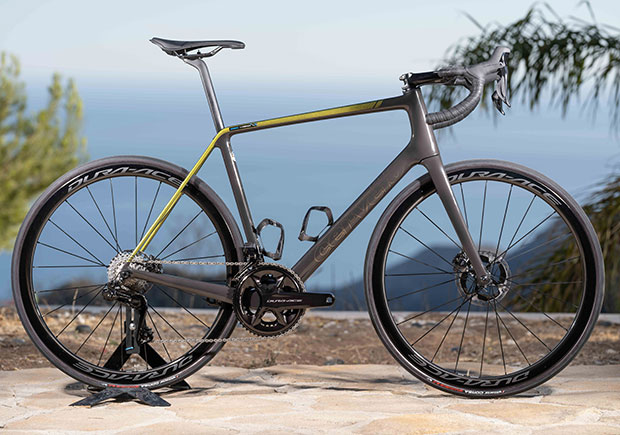
The other road bike I bought was an aero road bike (a Quintana Roo SRSix) and it makes sense to have the hydraulic lines running entirely inside the bike; and the SRAM Force AXS groupset was an easy build since it is entirely wireless. The R5 also has almost no exposed cables, but the hydraulic brake lines briefly live outside the bike just long enough to let me change handlebars and stems without a complete reroute and rebleed of those lines or by the use of an in-line hydraulic quick-connect (see the close up below of where the brake lines enter the frame). I built this R5 a bike for climbing! I don’t need it wring every last aero watt out of it at 30mph.
This bike, built, with water bottle cages, pedals, ready to ride, weighs 15 and three-quarter pounds, and there is nothing exotic about it (except perhaps the road handlebars and I’ll write about those some other time). The pedals are standard stainless steel Speedpdlays; the new Shimano groupset is no lighter than the one it replaced. Mostly it’s light weight is due to the R5 frameset, which with the fork ways just a tick over 1000 grams.
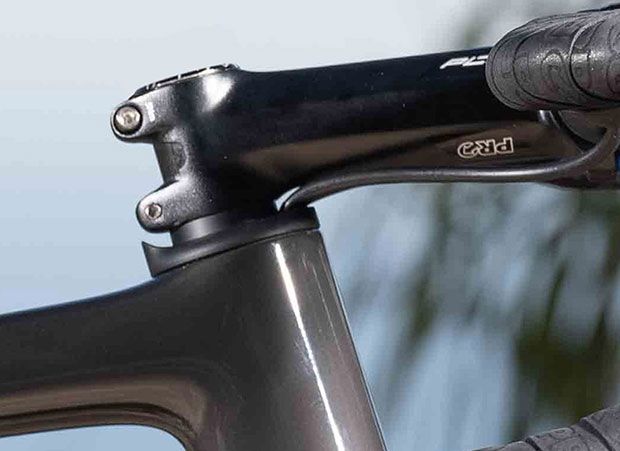
Fit
Weight is one reason why I bought this frame, but just one of several. I chose it also because it geometrically works for me. When Cervelo’s R-series road bikes first began to be popular (I’m fuzzy on the history, but sometime before 2008) the frame in size-58cm was long enough for me, with a reach of just under 400mm, but it was a bit tall with a stack of 605mm. I would say Cervelo has “inched” its front end lower since then but millimetered is more like it. It’s stack of 597mm is just barely low enough for me.
Note that if you invest in this frame you’re going to need to add about 15mm to the frame stack as a kind of mandatory headset dust cover because, while the hydraulic lines don’t pass through the stem they do enter the frame at that point of the headset (in the pic above) and that whole complex is not changeable. You can’t put a slam-that-stem dust cover on it.
This bikes comes in sizes 48, 51, 54, 56, 58, 61 and that’s been how Cervelo does it for as long as I can remember. They’re all built with 700c wheels. Cervelo’s view is that seat angles shouldn’t change as a bike gets smaller (that is, as a bike becomes of a size more often purchased by women). Cervelo does not believe in women’s geometry. Nor do I. However, if you keep the seat angle at 73° as the bike moves down to sizes 51 and 48, and you don’t lengthen the bike’s reach (that is, you don’t add top tube length), you’ll run into a shoe overlap problem. Cervelo solves this by changing the steering geometry. It slackens the head angle and adds fork offset. For example, in size 48 the bike has a 71° head angle and a 51mm fork offset. Doing both these things in tandem keeps the trail to 57mm, which it is throughout the line, from 48cm all the way to 61cm. (Read what I wrote about Cervelo’s Caledonia geometry and you’ll get a sense for this.)
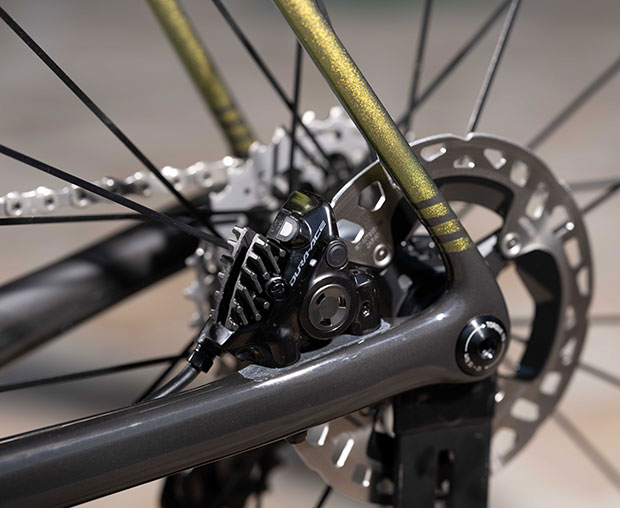
Using this method of scaling its sizes, the front:center (BB spindle to front wheel axle) of the R5 never drops below 573mm throughout the size run, which is a kind of magic number to forestall shoe overlap (the rider from hitting his or her shoe against the back of the front wheel as the wheel turns). You might think this is an irrational fear, because who pedals through a u-turn? Where you are most likely to have a shoe overlap problem is on a really steep climb, usually when seated, and you’re going so slow you need to turn the wheel sharply to remain balanced. That’s a nasty spot to encounter shoe overlap. No likelihood of that with this bike.
Handling
In size-54cm and up the geometry is what we call a “parallel 73”, meaning the seat and head angles are each 73°. This is very standard, very traditional road. This is this bike’s geometry from 54cm to 61cm, and the sizes from 51cm and down have shallower head angles, for the reason discussed just above.
When I first got my R3, back in what? – maybe 2011? – I found the bike extremely stable, but when I rode it out of the saddle the bike didn’t flow with me, in my rhythm. The bike felt like it had a lot of trail. It didn’t, but it felt like it, as in, it just wanted to go straight, like surfing a longboard. I attributed that to the bike itself being very stiff – the bike and the fork combined. There was era, let’s say between 5 and 12 years ago, when Cervelo did what a lot of frame makers unfortunately do: It worshiped at the altar of frame stiffness.
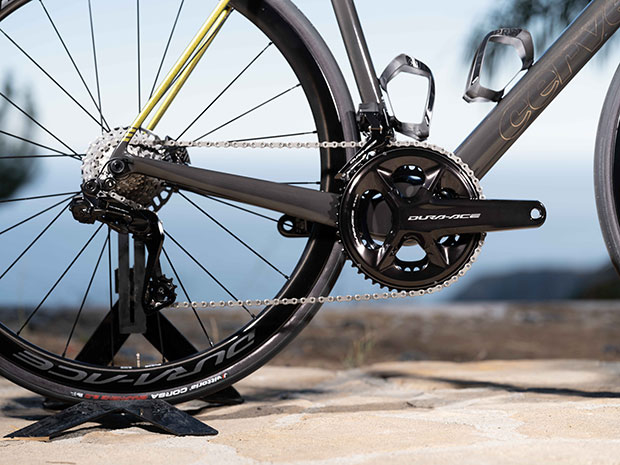
There was no give in that old R3, no flex, no “good” flex, like you might get in a ski. So – and remember the discussion above, where if you add fork offset (rake) you actually reduce trail, which speeds up the bike’s handling – I asked Cervelo to send me a fork for the R3 it put in the small-sized bikes. At that time they used a fork with a 53mm offset for the very small bikes (they use a fork with a 51mm offset today), and I took out the fork that came on the bike (43mm offset) and replaced it with the 53mm offset fork. I was a little afraid to ride the bike, and hiked my leg over the top tube with the fear I might get bucked off at some point during the ride. But the bike rode like a dream. Just quick enough in the front end to flow with me when out of the saddle, but it kept its extreme stability during high speed descents. The reduced trail counterbalanced the increased frame stiffness.
Why do I relate this story? Because this new R5 has a pretty similar steering geometry to that R3 with its original fork, but this bike is extremely lively. It’s reminiscent of that old R3 with the long-offset fork, except the ride is even more civilized (a tad less of a bone rattler, but in honesty a lot of that is due to my choice of wheels and tires). In fact, this new R5 is more lively yet because the front of this bike is so light. It took some getting used to, mostly on twisty descents. This new R5 wants to oversteer until you get comfortable with it, only because it is so light: It takes less steering input to execute X degrees of a turn.
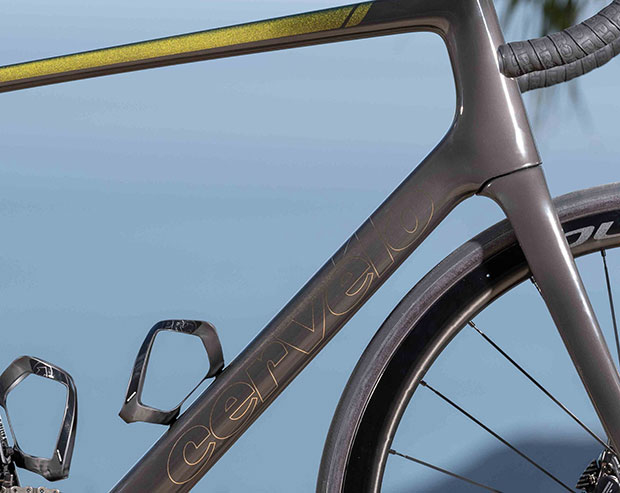
Big respect to the designers and engineers of this bike: It is not simply stiff for stiffness’s sake. It’s appropriately stiff.
Tube shapes
Cervelo learned way back when what I learned even further back than that (because I’m older, and got an earlier start in bike making): The seat stay is not a hot tube. Down tubes, top tubes, are hot tubes because they’re subject to a lot of stress.
But not the seat stays. They just sit there unperturbed. So, you can build them down; make them small and light. Cervelo learned which tubes it needs to make big in diameter, so it can make them thin in the wall, taking weight out of the frame. It gives the frame an interesting look. It’s beefy in the down tube, near the front of the top tube, and in the head tube and the top of the fork and all around the bottom bracket. The tubes are very thin elsewhere. The tube shape is Squoval Max, Cervelo’s square-oval attempt to wring every scintilla of structure out of a tube. The seat post isn’t exactly round. It’s got a kind of Kam tail as the trailing edge, and that squared-off shape may cause you to think you’ll need to friction paste the heck out of it to get it to stay but, honestly, it stays. It resists slipping better than Cervelo’s Caledona 5 seat post (which will not stay put without friction paste).

Capacity to make this bike yours
When I first got a Caledonia 5 to ride, I was taken with the GoPro mounts featured in the seat post and stem. The new R5 has the same, which is good because that squared off seat post is not a natural fit with any of the Garmin Varia mounting hardware. Yes, you can just mount that Varia flat against the post, but then it sits at a 17° angle, and that’s okay, the radar still functions and the blinker still shines fine. But I’m kind of obsessive about stuff like that so I’m glad the GoPro seat post mount made it onto this bike.
When I write about making “this bike yours” I’m not referring to creative financing options. It’s that we start with bike as they sit on showroom floors, and at some point we end – hopefully – with bikes that are extensions of our bodies. This is why we are picky about touch points: saddle, shoes, handlebars, shifters, even the handlebar tape. This is why I want a bike to respond underneath me when I apply pedaling, balancing, steering inputs (which I describe above). But the contact points – the tactile elements – and where they sit in space, this is when the electricity hits an inanimate Frankenstein’s monster and makes him live. Making it yours is what makes the bike live.

We do, for example, consider it appropriate to change the saddle, do we not? In this spirit, I would like the freedom to change the handlebars, and to place them exactly where I want them. When I went a-hunting for a climbing bike, the field narrowed quickly because I needed it in my geometry; I needed it lightweight; I needed it to handle well; and it’s hard to find a frame of that quality with a front end you can change to suit. I got from 200 possible bike models down to 1 bike model with about an hour of research.
I’ll be writing more about how I chose to outfit this particular bike – to make it mine – but the point here is that Cervelo allowed me the dignity to make it mine. This inability to make a bike yours – this lack of respect for the rider – is a cancer on our industry right now and even Cervelo, with bikes like its S5, is not immune to making what is basically a motorless motorcycle, which you purchase and take home and your freedom to adjust the bike to suit is limited to fixing your saddle height and precious little more. (Of course, remember that I’m obsessive about this.) This is why I am much more taken with Cervelo’s Caledonia, its R-Series, the Aspero, its tri bikes, and this terrific bike I’m writing about now.
Builds and price
This new R5 launch comes after the Shimano 12sp launch and I’m gratified that all of the 4 available builds for this bike are 12sp. This is not an inexpensive bike, with the two SRAM builds – Force AXS and Red AXS – priced at $8,400 and $12,000 respectively. The Dura Ace 9200 price is also $12,000 and Ultegra 8100 is priced at is $8,700.
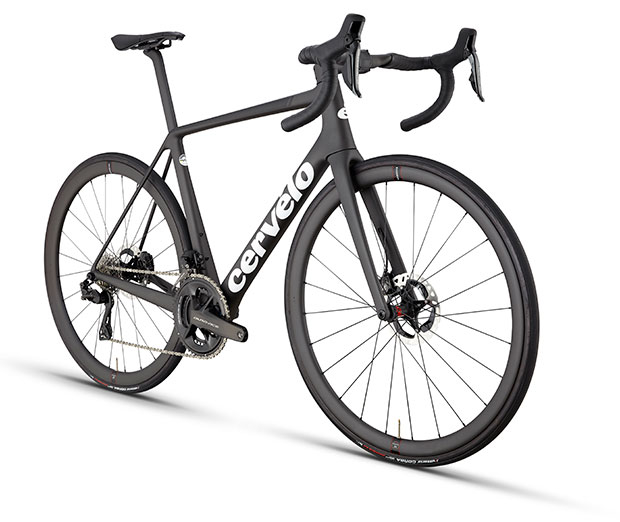
First, save yourself some money. Unless you’re a hedge fund manager or a trust fund baby, buy AXS Force. I’ve ridden both RED and Force and if it really bugs you to ride a level down then paint RED over the Force logo. Force AXS is really top level stuff. Heck, Rival AXS is top level stuff. Also, both the SRAM builds come with Quarq power meters installed, and more importantly I think both are currently available on this bike. (Shimano-equipped R5s are still making their way to your LBSs.)
The Shimano builds have exactly what I’m riding now (see my comments on new Shimano 9200): 53×36 and 11-30. But, look, this is part of making that bike your own. Is a 36×30 the lowest gear you need? For me, no. I do a lot of riding where the pitches exceed 20 percent; and I’m not a featherweight; and I’m 4 months from qualifying for Medicare. So, I need more like 50×34 and 11-34, which is what I’m putting on this bike once it’s available. (Shimano is a little tardy in the release of these lower gear options.) This bike is expensive enough you should demand the gearing you need. So demand it, at the point of sale, at your local bike shop. Just, remember the shipping logjam problem we’re in. Your bike shop owner can’t helicopter to one of the 60 container ships idling offshore at the Long Beach port to get you your cassette.
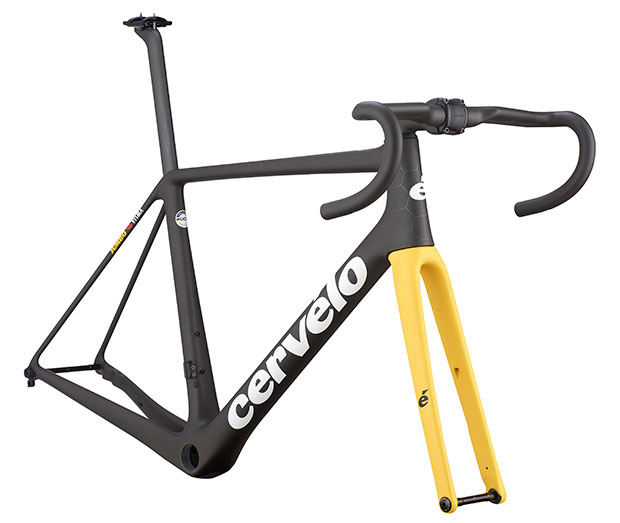
Now, about gearing. The SRAM Force option gearing is 48-35 and 10-33, and that 35×33 as the low gear is more appealing to me, with my limitations and imperatives. The RED build swaps in a 10-28 cassette for the 10-33. Memo to Cervelo: Those who can afford RED only can afford RED because they work long hours in offices all day. If anything, they need lower gears than those who can afford Force.
Cosmetics
My wife wants a new road bike. We go over the list of things unique to her, and we do the problem solving and sorting and we come up with the list of bike brands and models that make sense. Then she says, “Great. What about a Cervelo?” As if we didn’t just do all that problem solving and sorting.
Why? My R5 is in the Lime/Black colorway. Because she’s seen the Caledonia 5, the Aspero, and this new R5 that have passed through my workshop for launches and road tests, and she has come to the conclusion that nobody does paint and cosmetics like Cervelo. Her point is hard to dispute.
Read more about Cervelo’s new R5. And finally, a shout out to Shimano. They hung the Shimano 9200 parts on this frame of mine, and then kindly took the time to photo the complete bike and it’s mostly their photos you see here.


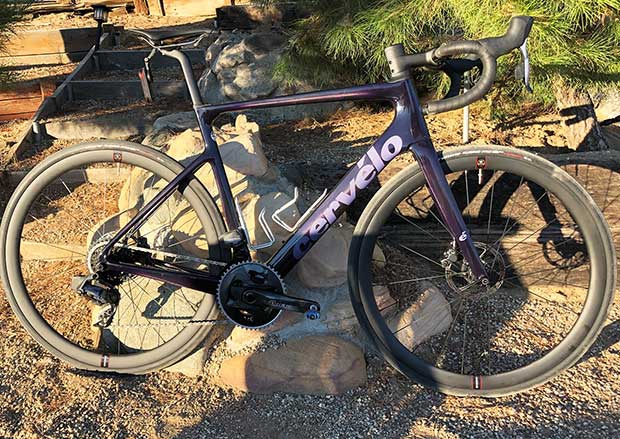
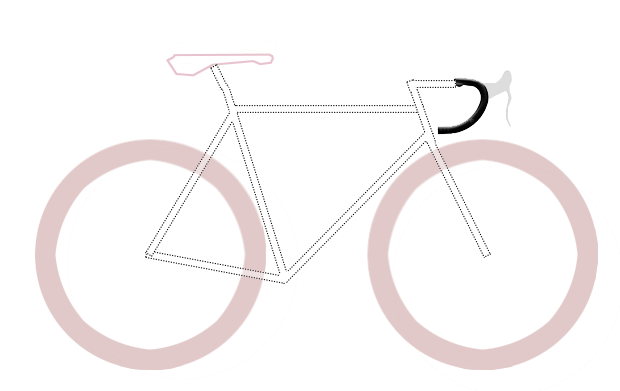
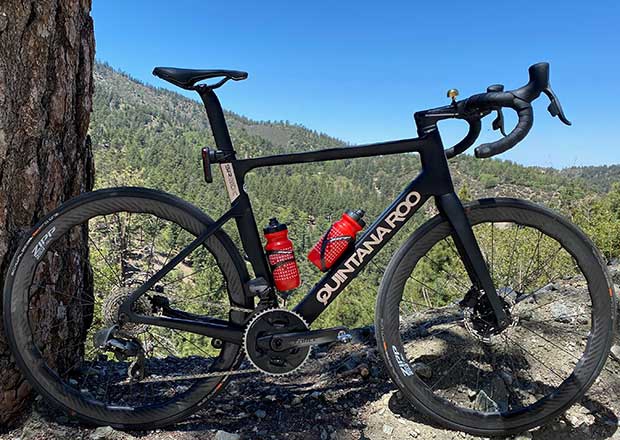
Start the discussion at slowtwitch.northend.network